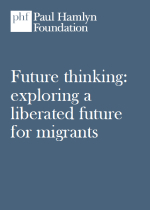Grantee and Applicant Perception Report
Feedback from the people they work with is important to all types of organisation. For the Paul Hamlyn Foundation, an important source of feedback is the survey of our grantees and applicants carried out by an independent agency, the Center for Effective Philanthropy. We commissioned the Grantee Perception Report early in 2013, in a repetition of the same exercise conducted in 2009. This year we also surveyed unsuccessful applicants to the organisation. It is the first time any UK Foundation has surveyed applicants in this way, and the first time a UK Foundation has repeated the Grantee Perception Report survey.
The exercise has provided us with a rich seam of data about our grantees’ and applicants’ experiences of working with us, our processes and the support we provide. Coupled with results from our earlier research, we now have, for the first time, a measure of change over time, benchmarked to our own earlier performance and to a large population of other Foundations from around the world.
More information about the Grantee and Applicant Perception Reports can be found at the Center for Effective Philanthropy website,
Main findings from the research
We have published a summary of the results of the surveys on our website. The full findings are detailed and rich, giving us a great deal to consider as part of our strategic review. However, there are some particularly strong messages that emerge from the work. These are:
Grantees’ overall satisfaction level with their relationship with PHF has remained consistent in the years since our first GPR. There has been a small increase in perception of the Foundation’s impact on grantees’ fields, and a small decline in perception of impact on grantees’ organisations. Most changes in the intervening period are not statistically significant.
A larger proportion of grantees receive ‘non-monetary assistance’, such as help in developing performance measures and involvement in seminars and other events organised by the Foundation. Respondents who received this type of assistance, on top of their funding, reported a greater level of satisfaction with us overall.
Our application processes continue to require a great deal of input from applicants. The time spent per application rose during the period 2009-13. However, our average grant size also increased, and the ratio of funds granted to hours spent applying has remained remarkably constant. Where necessary, we continue to work closely with second stage applicants to ensure strong proposals are put to our trustees for approval.
Broadly, the further an applicant progresses, the more beneficial they find our application processes in strengthening the plans for the work they were hoping that we would fund. Unsurprisingly, grantees rate us higher than unsuccessful applicants, but perhaps less predictably, those that are unsuccessful at the second stage of our process rate us more highly than those whose applications are declined at the first stage. It is clear that we are not providing sufficient feedback to unsuccessful applicants, particularly those who are turned down early in the process.
Our evaluation and reporting processes are also time-consuming for grantees but they were rated highly for their helpfulness in strengthening the funded work.
What we have done
After the 2009 survey we set ourselves three main objectives. First, we wanted to increase our level of non-monetary assistance, providing support in meaningful patterns that would positively impact organisations. The 2013 report shows that more grantees are receiving certain forms of support, including assistance with developing collaboration and partnerships. Our ‘Fitter for purpose’ pilot scheme started with selected grantees during 2012/13, but is too recent to have influenced the GPR scores. It provides further support for organisational development.
Second, we undertook to improve the pattern of engagement with grantees through the life of a grant. We have now changed the way we ‘contract’ with grantees, introducing a relationship agreement, which outlines some principles for how we want to relate with grantees. We also began to make more systematic contact at key points in the grant, including at the end. However, these changes are difficult to measure within the data we have obtained and it is too early to see their full impact.
Finally, we committed to focusing more on learning from the work we fund, to increase our impact on sectors and at a policy level. We have substantially increased our own capacity in this area and redrafted our guidance on setting and measuring outcomes.
It is clear from the most recent findings that while we have seen some changes in the first and third of these areas, we still have some way to go in the second. Some of the later changes we have made are not reflected in the survey findings.
What we will do now
The surveys provide a large set of data from grantees and applicants that will provide important evidence for our strategy review. We will consider what we can do to improve the ratings grantees give PHF for the quality of the funder-grantee relationship, interactions and communications. All of these things are known to support grantees to achieve their own objectives and to help the Foundation to have a greater impact in its chosen areas. We will also review the processes we require grantees to follow, to ensure an optimum balance between value to grantees and demands on their time. Changes will be implemented as part of the new strategic plan for PHF, in 2014.
However, there are things that can be adjusted within our current framework to tackle some pressing issues:
- We will begin to give more detailed feedback to unsuccessful applicants on the reasons why their requests were turned down. Through our website, we will report on the common reasons for applications being unsuccessful. We hope this will help applicants to develop proposals that are a better fit with our programmes’ funding criteria and priorities.
- We will review our first stage application processes to see if there are small changes that we can make now, in advance of concluding our strategic review, which will speed up the application process.
More information
A summary of the findings from the grantee and applicant surveys is published linked below. Because this data will feed into our strategy review we are also publishing this article on our strategy review blog, http://www.phfshould.wordpress.com/ and welcome comments on the findings. You can contact us directly about this or any other aspect of our review at should@phf.org.uk.


